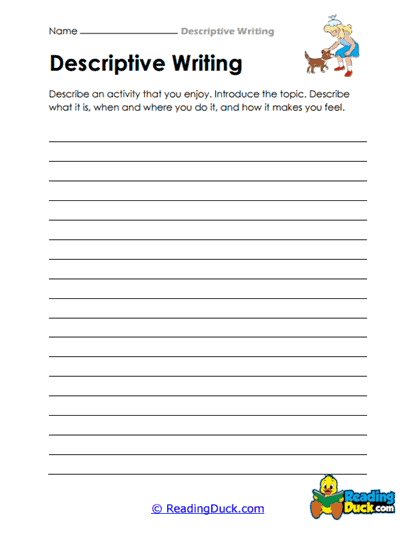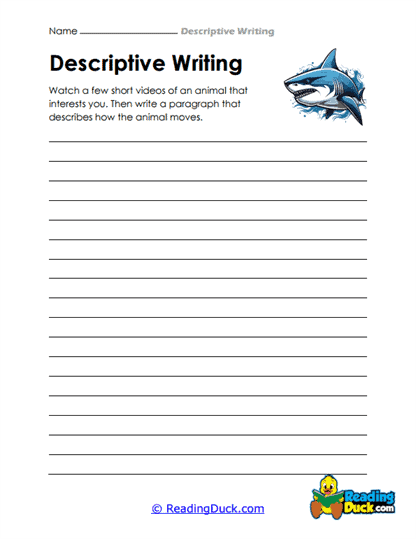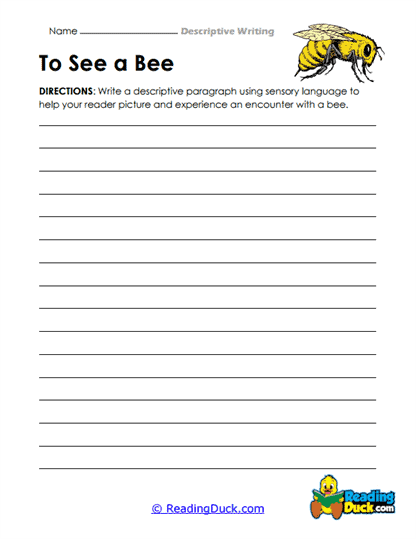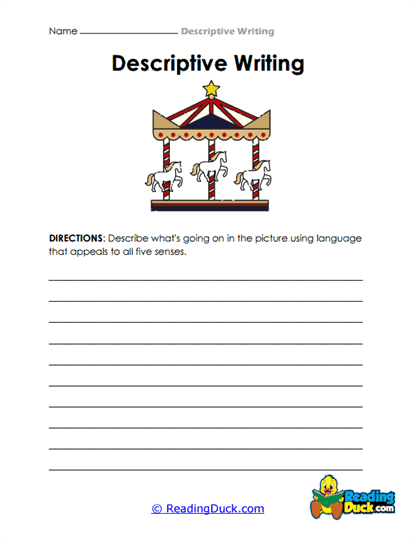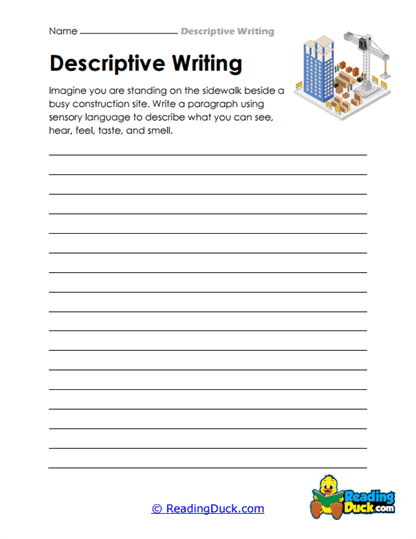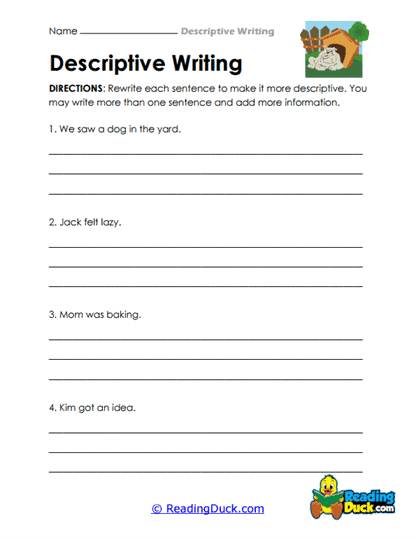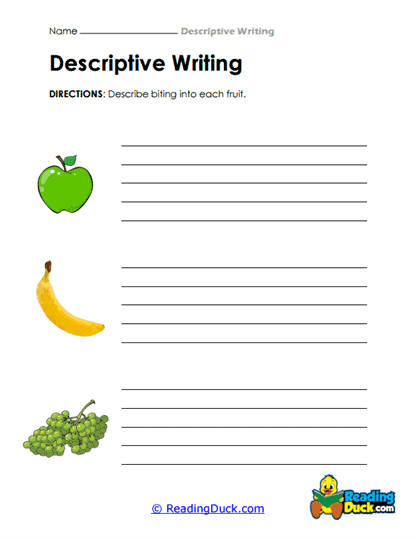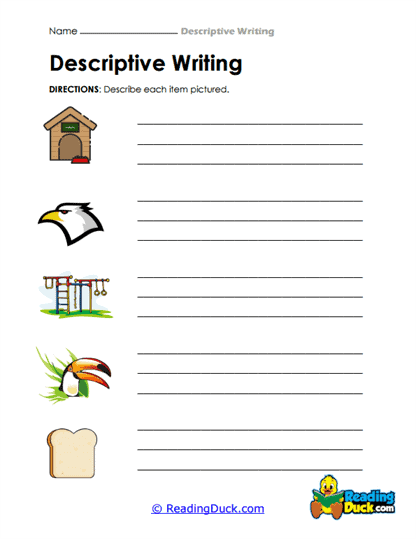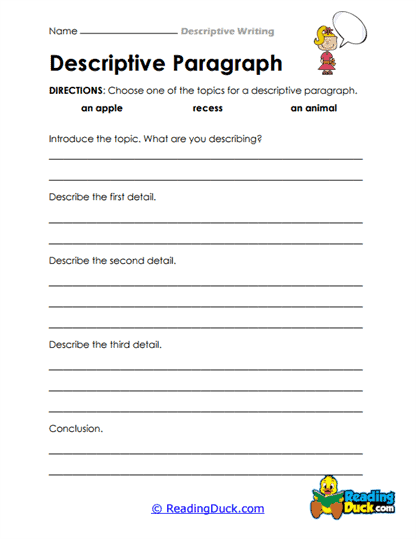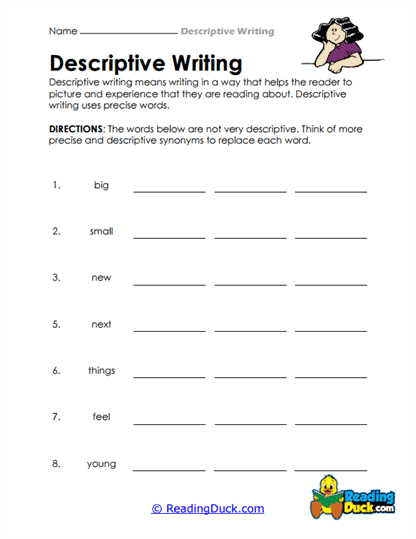Descriptive Writing Worksheets
About Our Descriptive Writing Worksheets
Our Descriptive Writing Worksheets are specifically designed to help students develop the essential skill of using vivid language to describe people, places, objects, and experiences. These worksheets guide students in crafting detailed, sensory-rich descriptions that captivate readers and make their writing more engaging. By focusing on descriptive writing techniques, students can enhance their creativity, expand their vocabulary, and learn to communicate ideas with greater clarity and impact.
Ideal for elementary and middle school students, this collection of worksheets is perfect for use in classrooms, homeschool settings, or independent learning environments. The step-by-step exercises are easy to follow, helping students build their skills gradually while encouraging them to explore their unique voice and style. Through structured practice, students will improve their ability to create more vivid, engaging, and effective writing across all subjects.
What Is Descriptive Writing?
Descriptive writing is a form of writing that focuses on providing detailed descriptions of people, places, objects, or events using rich, sensory language. The goal of descriptive writing is to create a vivid picture in the reader's mind, allowing them to experience the subject as if they were there themselves. By engaging the senses—sight, sound, touch, smell, and taste—descriptive writing makes scenes come alive, making the writing more memorable and impactful.
Key elements of descriptive writing include:
- Sensory details: Writers use words that describe how things look, sound, feel, taste, and smell to help readers fully experience the subject.
- Precise vocabulary: Instead of relying on vague or general words, descriptive writers choose specific, vivid adjectives and verbs that create strong imagery.
- Figurative language: Similes, metaphors, and personification can add depth and creativity to descriptions, comparing objects or experiences to familiar concepts.
- Focus and clarity: Strong descriptive writing stays focused on the subject and organizes details in a logical order, allowing the reader to follow along easily.
For example:
- Simple description: The flower is pretty.
- Descriptive writing: The vibrant pink petals of the flower glistened with morning dew, their delicate fragrance floating gently through the crisp air.
In this second example, the writer paints a picture for the reader, helping them imagine the appearance and scent of the flower. This kind of writing elevates ordinary objects and moments, making them more vivid and engaging. Learning to write descriptively enhances a student’s ability to convey their ideas clearly and with impact.
How These Worksheets Support Key Learning Objectives
Our Descriptive Writing Worksheets are thoughtfully crafted to align with the key objectives found in writing curricula, ensuring students develop the skills they need to succeed academically. Descriptive writing is essential for building strong communication skills, and these worksheets provide targeted practice in areas such as sentence structure, coherence, and expressive clarity.
Key learning objectives supported by these worksheets include:
- Improving sentence structure: Students practice crafting detailed, complex sentences that flow smoothly and avoid repetition. This helps them write with greater variety and creativity.
- Enhancing coherence: By organizing their thoughts clearly and logically, students learn to write descriptions that make sense and guide the reader effortlessly from one idea to the next.
- Developing clarity and precision: Descriptive writing demands that students choose words carefully. These worksheets focus on helping students find the right words to express their ideas clearly and in a way that paints vivid pictures for the reader.
These worksheets can be seamlessly integrated into larger writing units or project-based learning activities. For example, teachers might use these worksheets to support narrative writing projects, where students need to describe settings or characters. Similarly, in science classes, students could use their descriptive writing skills to detail observations during experiments or fieldwork.
Nurturing Creativity and Expression Through Descriptive Writing
Descriptive writing is not only about honing technical writing skills—it’s also a powerful way for students to express themselves and explore their creativity. Our Descriptive Writing Worksheets encourage students to experiment with language and discover their own unique writing style. Whether describing an object, a scene, or an experience, students are guided to think critically about how they can use language to evoke emotions, set a mood, or create vivid images.
Here’s how these worksheets foster creativity and self-expression:
- Expanding vocabulary: The exercises prompt students to move beyond basic adjectives and verbs, encouraging them to use more dynamic and imaginative language.
- Personal expression: By asking students to describe objects or scenes from their own lives or imaginations, these worksheets give students the freedom to express their personal perspectives and emotions.
- Encouraging visual and sensory thinking: Students are encouraged to visualize what they’re describing and think about how it looks, feels, sounds, and smells, fostering deeper engagement with their writing.
For example, when students are tasked with describing a special place, they may write about a familiar park or a room in their house. Instead of simply stating "The park is big," they might write, "The sprawling green park stretched out before me, the soft rustle of leaves whispering in the breeze, and the scent of freshly cut grass filling the air." This kind of description not only informs the reader but also draws them into the experience, creating a deeper connection between the writer and their audience.
Easy-to-Follow Instructions and Minimal Preparation
One of the major advantages of our Descriptive Writing Worksheets is their ease of use. Designed to be accessible for both teachers and students, these worksheets require minimal preparation, making them ideal for quick lessons, homework assignments, or independent practice. Each worksheet is structured with clear instructions, ensuring students can work through the exercises on their own or with minimal teacher guidance.
Each worksheet typically includes:
- Examples: Students are shown examples of effective descriptive writing, helping them understand how to craft their own descriptions.
- Guided practice: Step-by-step exercises walk students through the process of creating detailed descriptions, building from basic sentences to more complex paragraphs.
- Reflection and revision: Some worksheets include space for students to revise and improve their descriptions, teaching them to reflect on their writing and make improvements for clarity and impact.
These worksheets are a time-saving resource for teachers who want to introduce or reinforce descriptive writing skills without extensive preparation. They can be used as standalone exercises or as part of a larger writing workshop, giving students plenty of opportunities to practice and refine their descriptive writing abilities.
Versatile Use in Any Learning Environment
Our Descriptive Writing Worksheets are designed to be adaptable for a wide variety of learning environments, making them a valuable resource for teachers, parents, and independent learners alike. Whether you’re teaching in a traditional classroom, an online setting, or a homeschool environment, these worksheets provide flexible, practical support for students looking to improve their descriptive writing skills.
- Classroom use: Teachers can use the worksheets as part of a structured writing unit, assign them for group activities, or offer them as independent practice during writing centers.
- Homeschooling: Parents can easily integrate these worksheets into a homeschool curriculum, ensuring that their children develop strong writing skills through structured, engaging practice.
- Remote learning: The worksheets are perfectly suited for digital distribution, making them ideal for distance learning or virtual classroom environments. Students can complete the exercises on their own, submit their work online, and receive feedback from their teachers.
- Independent study: Students who are self-motivated can use these worksheets to practice descriptive writing on their own, improving their skills at their own pace.
This adaptability ensures that the worksheets can meet the needs of different students, regardless of their learning environment. Teachers and parents can tailor the exercises to suit the individual needs of their students, making them a versatile and practical tool for writing instruction.
Our Descriptive Writing Worksheets are a comprehensive and engaging resource for helping students improve their writing through detailed, vivid descriptions. By focusing on sensory details, precise vocabulary, and creative expression, these worksheets give students the tools they need to bring their writing to life. Whether used in classrooms, homeschooling settings, or for independent study, these worksheets offer structured, practical exercises that build foundational skills in descriptive writing.
With clear instructions, minimal preparation, and the flexibility to be adapted for various learning environments, this collection is an essential resource for educators, parents, and students who want to improve writing skills. These worksheets help students not only master the technical aspects of descriptive writing but also develop their unique voice and style, setting them up for success in all types of writing assignments.
